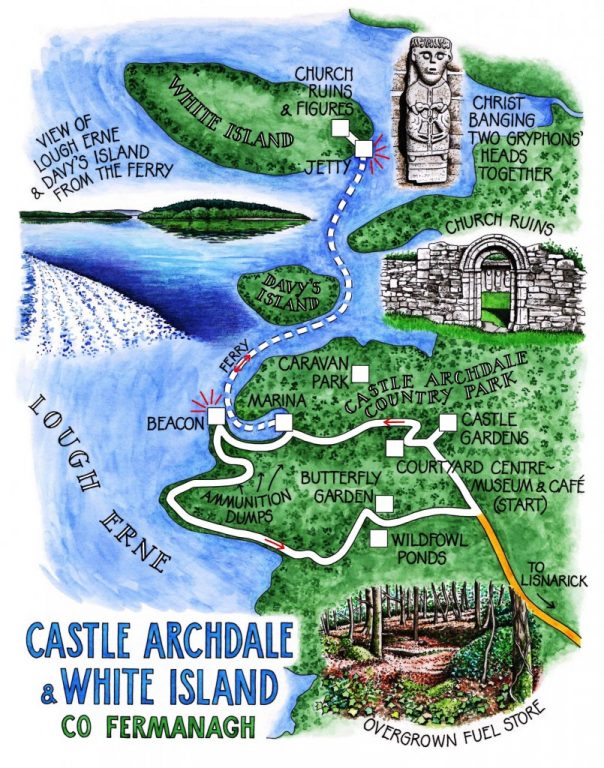Irish Independent – WALK OF THE WEEK – Christopher Somerville
3 July 2010
65. Castle Archdale and White Island, Co. Fermanagh

On a lovely summer morning the White Island ferry, zooming across the glassy waters of Lower Lough Erne from Castle Archdale marina, had me landed on the tree-encircled island in somewhat less than a jiffy.
The wartime roar of Sunderland and Catalina flying boats, the suck and hiss as they took off from the lake, the thump and splash as they set down – none of these disturbed the stony staring of the eight watchers of White Island, who had been guarding their islet off Castle Archdale for at least a thousand years when war came to County Fermanagh in 1941. Today, exploring the ruined church and the enigmatic figures ranked along its wall, I felt that frisson one experiences in the presence of ancient likenesses of the human form.
Who or what had that Dark Ages sculptor been trying to represent? He certainly carved a saucy sheela-na-gig, legs akimbo, who now flashes her monkey grin at one end of the line. The other end is closed by a sulky face. But what of those others in between? Round-eyed, bearing blank expressions and holding mysterious, weather-blurred objects … Were these a saintly scribe, a bishop, St David singing with a harp? Two versions of Christ, one banging the heads of two gryphons together, the other a curly-haired warrior with round shield and stabbing sword? Or did their creator have something altogether different in mind when he set to with his chisel on the quartzite slabs he’d smoothed? One stone he left with only the ghostly outline of a figure. What prevented him finishing his great series – sickness, an enemy raid, death? I sat on the landing stage and waited for the ferry back to Castle Archdale with a head full of speculation.
A World War II heritage trail loops round the headland where in 1615 the ‘planter’ John Archdale, fresh over in Ulster from Suffolk, built a fortified stronghold. The castle is long gone, but its walled courtyard holds a fascinating wartime exhibition. Lough Erne was perfectly placed (once a secret deal over airspace had been struck with the Republic) for reconnaissance and U-boat hunting trips out into the Atlantic, and the wooded peninsula became home to thousands of youngsters from many corners of the world. I learned with admiration of those flyers from Britain, Canada and the US, their stolid courage on the job, and the high jinks they got up to back at base in order to let off steam.
Walking the trail, I crossed beautiful woodland where the horse chestnuts were displaying the faded remnants of pink and white candle flowers. Under the trees crouched the shapes of fuel and ammunition stores smothered under moss and ivy, as overgrown and ancient-looking as Stone Age huts. It was strange to walk with so many ghosts – down on the marina with its big white beacon and memorial stone to wartime crash victims, and out along the ‘Burma Road’, a jungly path cut through the forest to reach the isolated explosives dumps. These days a caravan park covers the maintenance apron where the flying boats were repaired, and bluebells carpet the glade where Canadian aircrew once roomed in Nissen huts that were nicknamed ‘Skunk Hollow’ because their sewers gave out an ineradicable stink. From here the young lads would escape to local bars and dance halls, to laugh and drink and jive and jitterbug like hell.
Down on the lake path the view was of low hills reflected in wide water. Coots honked stridently from the reed beds. A swan came in from the open lake, sawing its wings, as white and lumbering as a Sunderland flying boat. It skated along the water, kicking up a bow wave. A shiver of folding wings, a shake of the neck, and it was sailing serenely to shore. All seemed right with the world under the blue Fermanagh sky; and as I passed ponds shimmering with water boatmen and turned back towards the Courtyard Centre, I could only hope that those young Air Force men and women, at war and far from home, had snatched some precious moments such as these.
WAY TO GO
MAP: OS of Northern Ireland 1:50,000 Discoverer 17; downloadable maps/instructions at www.walkni.com
TRAVEL:
Rail/bus (integrated website – www.nirailways.co.uk): Ulsterbus 194 (Pettigo-Enniskillen) to Lisnarick (1 mile)
Road: Signed off B82/B72 at Lisnarick (postcode BT94 1PP)
WALK DIRECTIONS (World War 2 Heritage Trail marked with numbered posts): From Courtyard Centre descend steps to car park; sharp left past ‘No Entry’ sign on path through trees. Follow ‘Woodland Walk’ signs to roadway. Left for 30 yards; right to marina. Left to beacon; left along shore path; bear right at yellow marker, continue on cycle track. At another yellow marker, right to shore path. Follow it through Skunk Hole car park. Follow ‘Butterfly Garden’ past pond, butterfly garden and deer enclosure. Dogleg right and left to gate at drive (don’t go through!). Left along path; right to castle gardens.
LENGTH: 2½ miles: allow 1-2 hours
GRADE: Easy
RATINGS: 3 buggies, 2 binoculars
DON’T MISS … !
• World War II exhibition
• White Island
• Butterfly garden
REFRESHMENTS: Tearoom, 11-6 – July-August daily; Sep weekends
GUIDE BOOKS/LEAFLETS: available at Visitor Centre
INFORMATION: White Island ferry (028-6862-1892): July-August daily, 11-5; Sep weekends
Castle Archdale Visitor Centre: 028-6862-1588; July-August 11-7, Tue-Sun;
www.ni-environment.gov.uk/places_to_visit…/parks/archdale.htm
WALKING: Walking tour operators, local walks including Discover Ireland’s National Loop Walks and Northern Ireland’s Quality Walks, walking festivals throughout Ireland: www.walkni.com; www.discoverireland.ie/walking
Other information: www.discovernorthernireland.com
csomerville@independent.ie